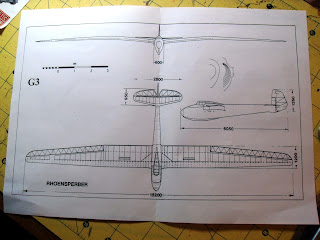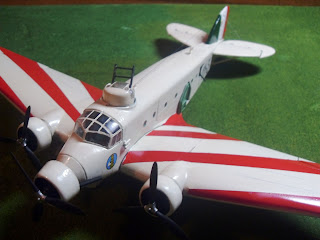Yes, the SM81 torture continues, but, at least, it is now looking something like an aircraft:
As you can see, it is at the stage where one could (if one was so inclined) walk around with it above one's head making engine noises. If one wanted to that is.

I've been looking through old copies of Air Pictorial the last few days, reading the long series, 'East Africa Air War' by Christopher Shores and Corrado Ricci that was published in 1983 and 1984. Shores, of course, is a well known aviation historian, while Ricci was a veteran of the campaign. It was a very detailed account, illustrated by marvellous, rare photographs. For those interested in the esoteric, the campaign is fascinating, with aircraft such as the Junkers 86 and Junkers 52 seeing action - on the British and Imperial side, as part of South Africa's contribution. But of rarebirds there were many: Wellesleys, Hartbeestes, Furies, Gauntlets, and, amazingly, a Vickers Valentia used as a night bomber! On the Italian side, CR32s and Caproni Ca133s were deployed, along with more modern types like the CR42 and SM79. The SM81 was also very active in the bombing role. Of course, the standard of equipment of most of these types was, for 1940/41, poor - no armour, mixed construction, and limited range being the norm. The SM81, for example, had wooden wings and a fabric covered fuselage with no armour protection for the crew. It doesn't need much imagination to think what it must have been like to be attacked while flying in an aircraft like that.
One account of the downing of an SM81 by Wellesleys was given in Part 3 of Shores and Ricci's history:
'F/O C G S R Robinson, who was flying one of the "up-gunned" Wellesleys (armed with four Lewis guns as well as his forward-firing Vickers) approached from astern and dived to attack the Savoia. This initial attack appeared to have no result, so he climbed back up, and repeated the attack. His gun then jammed, and as the Savoia's crew were now returning fire, he pulled away momentarily. Next, he pulled the Wellesley close alongside to allow the gunners to get a good shot; Cooke, the upper gunner, and Fell with the starboard gun, both opened fire [...]'. As a result, the co-pilot, the dorsal gunner and the waist gunner were wounded. The SM81 tried to put down on a small island, but the Wellesley's gunners were still shooting into the fabric covered aircraft and the pilot was killed. The SM81 crashed into the sea, and all the survivors, all wounded, struggled into the water. Their life-raft took three men, but the fourth, Franchini, realised that if he climbed aboard then the raft would sink. He ordered his crew mates to make for the island, while he hung on to a piece of wing. Franchini was never seen again, but the other three eventually, after two weeks, were found. I could make some remarks about the human condition, but they would, inevitably, be too shallow.
A couple of days ago, the sun came out over much of old England, and the crocuses in my garden responded:
That evening, in the darkness, a blackbird sang at length encouraging the Spring to arrive.














































